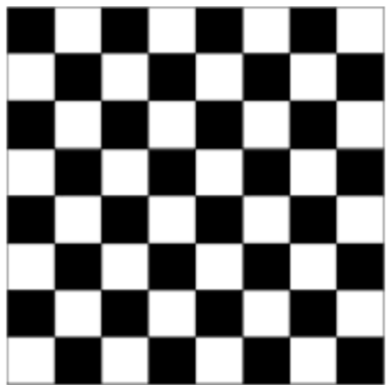
The number of ways of selecting two squares on chessboard such that they have a side in common is
A. 225
B. 112
C. 56
D. 68
Answer
141k+ views
Hint: Here, we will first start with drawing a diagram of chess-board and find the total number of rows in a chess board and then make pairs of two consecutive rows to find the number of ways of selecting two squares on the chessboard such that they have a side in common.
Complete step by step answer
Let us examine the figure of the chessboard given below.

Now consider the first and the second row of the chessboard in the diagram above.
In the first and second row, we have 14 ways to select two squares that have only one common side.
Similarly for the second and third row, we have 14 ways to select the squares.
Since there are only 8 rows, so we can pick 8 such pairs of rows in a chessboard.
Now we will find the number of ways of selecting two squares in a chess board that have only one common side.
\[14 \times 7 = 112\]
Thus, there are 112 numbers of ways to select such squares.
Hence, the option B is correct.
Note: In this question, we have to examine the chessboard carefully.
We know that the chessboard is symmetrical in shape. So if the number of two squares having one side common in two consecutive rows is 14 then we just have to calculate the number of consecutive rows than can be taken.
Complete step by step answer
Let us examine the figure of the chessboard given below.

Now consider the first and the second row of the chessboard in the diagram above.
In the first and second row, we have 14 ways to select two squares that have only one common side.
Similarly for the second and third row, we have 14 ways to select the squares.
Since there are only 8 rows, so we can pick 8 such pairs of rows in a chessboard.
Now we will find the number of ways of selecting two squares in a chess board that have only one common side.
\[14 \times 7 = 112\]
Thus, there are 112 numbers of ways to select such squares.
Hence, the option B is correct.
Note: In this question, we have to examine the chessboard carefully.
We know that the chessboard is symmetrical in shape. So if the number of two squares having one side common in two consecutive rows is 14 then we just have to calculate the number of consecutive rows than can be taken.
Recently Updated Pages
Difference Between Mutually Exclusive and Independent Events

Difference Between Area and Volume

JEE Main Participating Colleges 2024 - A Complete List of Top Colleges

JEE Main Maths Paper Pattern 2025 – Marking, Sections & Tips

Sign up for JEE Main 2025 Live Classes - Vedantu

JEE Main 2025 Helpline Numbers - Center Contact, Phone Number, Address

Trending doubts
JEE Main 2025 Session 2: Application Form (Out), Exam Dates (Released), Eligibility, & More

JEE Main Exam Marking Scheme: Detailed Breakdown of Marks and Negative Marking

JEE Main 2025: Derivation of Equation of Trajectory in Physics

Electric Field Due to Uniformly Charged Ring for JEE Main 2025 - Formula and Derivation

Learn About Angle Of Deviation In Prism: JEE Main Physics 2025

Degree of Dissociation and Its Formula With Solved Example for JEE

Other Pages
JEE Advanced Marks vs Ranks 2025: Understanding Category-wise Qualifying Marks and Previous Year Cut-offs

NCERT Solutions for Class 11 Maths Chapter 6 Permutations and Combinations

JEE Advanced Weightage 2025 Chapter-Wise for Physics, Maths and Chemistry

JEE Main 2025: Conversion of Galvanometer Into Ammeter And Voltmeter in Physics

Electron Gain Enthalpy and Electron Affinity for JEE

Physics Average Value and RMS Value JEE Main 2025




